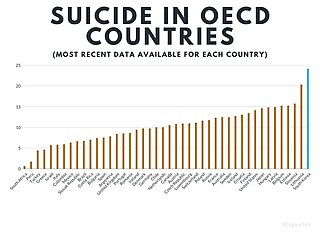Adjustment disorder is a maladaptive response to a psychosocial stressor. It is classified as a mental disorder. The maladaptive response usually involves otherwise normal emotional and behavioral reactions that manifest more intensely than usual, causing marked distress, preoccupation with the stressor and its consequences, and functional impairment.

Suicide prevention is a collection of efforts to reduce the risk of suicide. Suicide is often preventable, and the efforts to prevent it may occur at the individual, relationship, community, and society level. Suicide is a serious public health problem that can have long-lasting effects on individuals, families, and communities. Preventing suicide requires strategies at all levels of society. This includes prevention and protective strategies for individuals, families, and communities. Suicide can be prevented by learning the warning signs, promoting prevention and resilience, and committing to social change.
Suicide intervention is a direct effort to prevent a person or persons from attempting to take their own life or lives intentionally.

Suicidal ideation, or suicidal thoughts, is the thought process of having ideas, or ruminations about the possibility of ending one's own life. It is not a diagnosis but is a symptom of some mental disorders and can also occur in response to adverse life events without the presence of a mental disorder.
Suicide risk assessment is a process of estimating the likelihood for a person to attempt or die by suicide. The goal of a thorough risk assessment is to learn about the circumstances of an individual person with regard to suicide, including warning signs, risk factors, and protective factors. Risk for suicide is re-evaluated throughout the course of care to assess the patient's response to personal situational changes and clinical interventions. Accurate and defensible risk assessment requires a clinician to integrate a clinical judgment with the latest evidence-based practice, although accurate prediction of low base rate events, such as suicide, is inherently difficult and prone to false positives.

College health is a desired outcome created by a constellation of services, programs and policies directed at advancing the health and wellbeing of individuals enrolled in an institution of higher education, while also addressing and improving both population health and community health. Many colleges and universities worldwide apply both health promotion and health care as processes to achieve key performance indicators in college health. The variety of healthcare services provided by any one institution range from first aid stations employing a single nurse to large, accredited, multi-specialty ambulatory healthcare clinics with hundreds of employees. These services, programs and policies require a multidisciplinary team, the healthcare services alone include physicians, physician assistants, administrators, nurses, nurse practitioners, mental health professionals, health educators, athletic trainers, dietitians and nutritionists, and pharmacists. Some of the healthcare services extend to include massage therapists and other holistic health care professionals. While currently changing, the vast majority of college health services are set up as cost centers or service units rather than as parts of academic departments or health care delivery enterprises.
A suicide crisis, suicidal crisis or potential suicide is a situation in which a person is attempting to kill themselves or is seriously contemplating or planning to do so. It is considered by public safety authorities, medical practice, and emergency services to be a medical emergency, requiring immediate suicide intervention and emergency medical treatment. Suicidal presentations occur when an individual faces an emotional, physical, or social problem they feel they cannot overcome and considers suicide to be a solution. Clinicians usually attempt to re-frame suicidal crises, point out that suicide is not a solution and help the individual identify and solve or tolerate the problems.
Youth suicide is when a young person, generally categorized as someone below the legal age of majority, deliberately ends their own life. Rates of youth suicide and attempted youth suicide in Western societies and other countries are high. Youth suicide attempts are more common among girls, but adolescent males are the ones who usually carry out suicide. Suicide rates in youths have nearly tripled between the 1960s and 1980s. For example, in Australia suicide is second only to motor vehicle accidents as its leading cause of death for people aged 15 to 25.

Suicide is the act of intentionally causing one's own death. Mental disorders, physical disorders, and substance abuse are risk factors. Some suicides are impulsive acts due to stress, relationship problems, or harassment and bullying. Those who have previously attempted suicide are at a higher risk for future attempts. Effective suicide prevention efforts include limiting access to methods of suicide such as firearms, drugs, and poisons; treating mental disorders and substance abuse; careful media reporting about suicide; and improving economic conditions. Although crisis hotlines are common resources, their effectiveness has not been well studied.

Depression is a mental disorder characterized by prolonged unhappiness or irritability, accompanied by a constellation of somatic and cognitive signs and symptoms such as fatigue, apathy, sleep problems, loss of appetite, loss of engagement; low self-regard or worthlessness; difficulty concentrating or indecisiveness; or recurrent thoughts of death or suicide. Depression in childhood and adolescence is similar to adult major depressive disorder, although young sufferers may exhibit increased irritability or behavioral dyscontrol instead of the more common sad, empty, or hopeless feelings seen with adults. Children who are under stress, experiencing loss, or have other underlying disorders are at a higher risk for depression. Childhood depression is often comorbid with mental disorders outside of other mood disorders; most commonly anxiety disorder and conduct disorder. Depression also tends to run in families. In a 2016 Cochrane review cognitive behavior therapy (CBT), third-wave CBT and interpersonal therapy demonstrated small positive benefits in the prevention of depression. Psychologists have developed different treatments to assist children and adolescents suffering from depression, though the legitimacy of the diagnosis of childhood depression as a psychiatric disorder, as well as the efficacy of various methods of assessment and treatment, remains controversial.

Suicide in South Korea occurs at the 12th highest rate in the world. South Korea has the highest recorded suicide rate in the OECD. However, differences in recording practices across the world make accurate comparisons impossible. In South Korea, it is estimated to affect 0.02 percent of the population by the WHO. In 2012, suicide was the fourth-highest cause of death. The suicide rate has consistently declined between 2012 and 2019, the year when the latest data is available.
Research has found that attempted suicide rates and suicidal ideation among lesbian, gay, bisexual, transgender (LGBT) youth are significantly higher than among the general population.
Health issues of athletics concern the health and well-being of athletes who participate in an organized sport. If athletes are physically and mentally underdeveloped, they are susceptible to mental or physical problems. Athletes trying to improve their performance in sports can harm themselves by overtraining, adopting eating habits that damage them physically or psychologically, and using steroids or supplements.

United States military veteran suicide is an ongoing phenomenon regarding the high rate of suicide among U.S. military veterans in comparison to the general civilian public. A focus on preventing veteran suicide began in 1958 with the opening of the first suicide prevention center in the United States. During the mid-1990s, a paradigm shift in addressing veteran suicide occurred with the development of a national strategy which included several Congressional Resolutions. More advancements were made in 2007, when the Joshua Omvig Veterans Suicide Prevention Act created a comprehensive program including outreach at each Veterans Affairs Office (VA) and the implementation of a 24-hour crisis hotline. PTSD, depression, and combat-related guilt in veterans are often related to suicide as it can be difficult for veterans to transition to civilian life.

Mental health issues are prevalent in South Korea, with the highest suicide rate in the OECD and the highest rate of hospitalizations for mental illness among OECD countries. South Korea has state-funded mental health services, the majority of which are inpatient hospital facilities, but they are largely underfunded and underutilized. Despite the prevalence of mental illness, social stigma remains prevalent throughout the South Korean population, which discourages sufferers from seeking treatment. Mental illness, while present across all demographic groups, is most common among the elderly and adolescents in South Korea.
Suicide among Native Americans in the United States, both attempted and completed, is more prevalent than in any other racial or ethnic group in the United States. Among American youths specifically, Native American youths also show higher rates of suicide than American youths of other races. Despite making up only 0.9% of the total United States population, American Indians and Alaska Natives (AIANs) are a significantly heterogeneous group, with 560 federally recognized tribes, more than 200 non-federally recognized tribes, more than 300 languages spoken, and one half or more of them living in urban areas. Suicide rates are likewise variable within AIAN communities. Reported rates range from 0 to 150 per 100,000 members of the population for different groups. Native American men are more likely to commit suicide than Native American women, but Native American women show a higher prevalence of suicidal behaviors. Interpersonal relationships, community environment, spirituality, mental healthcare, and alcohol abuse interventions are among subjects of studies about the effectiveness of suicide prevention efforts. David Lester calls attention to the existence and importance of theories of suicide developed by indigenous peoples themselves, and notes that they "can challenge traditional Western theories of suicide." Studies by Olson and Wahab as well as Doll and Brady report that the Indian Health Service has lacked the resources needed to sufficiently address mental health problems in Native American communities. The most complete records of suicide among Native Americans in the United States are reported by the Indian Health Service.
Puerto Rico has been in economic crisis for a long time due to its unpayable debt. As of 2015 it is 72 billion dollars. The mounting debt has caused much damage to the society in question. Cutbacks on a lot of necessities in the island have caused a health care problem. In the mental health care, the problem grows bigger as people find themselves unemployed or with lack of good jobs a lot of people have left the island, causing a lack of professionals.
Suicide and trauma is the increased risk of suicide that is caused by psychological trauma.

Suicide cases have remained constant or decreased since the outbreak of the COVID-19 pandemic. According to a study done on twenty-one high and upper-middle-income countries in April–July 2020, the number of suicides has remained static. These results were attributed to a variety of factors, including the composition of mental health support, financial assistance, having families and communities work diligently to care for at-risk individuals, discovering new ways to connect through the use of technology, and having more time spent with family members which aided in the strengthening of their bonds. Despite this, there has been an increase in isolation, fear, stigma, abuse, and economic fallout as a result of COVID-19. Self-reported levels of depression, anxiety, and suicidal thoughts were elevated during the initial stay-at-home periods, according to empirical evidence from several countries, but this does not appear to have translated into an increase in suicides.
Youth suicide in India is when young Indian people deliberately end their own life. People aged 15 to 24 years have the highest suicide rate in India, which is consistent with international trends in youth suicide. 35% of recorded suicides in India occur in this age group. Risk factors and methods of youth suicide differ from those in other age groups.









